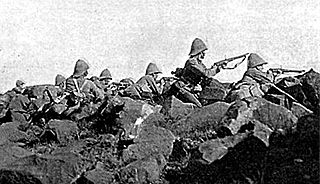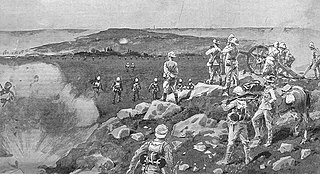
Ladysmith is a town in the Uthukela District of KwaZulu-Natal, South Africa. It lies 230 kilometres (140 mi) north-west of Durban and 365 kilometres (227 mi) south-east of Johannesburg. Important industries in the area include food processing, textiles, and tyre production. Ladysmith is the seat for both the Alfred Duma Local Municipality and Uthukela District Municipality.

Estcourt is a town in the uThukela District of KwaZulu-Natal Province, South Africa. The main economic activity is farming with large bacon and processed food factories situated around the town. The N3 freeway passes close to the town, linking it to the rest of South Africa.

The Battle of Spion Kop was a military engagement between British forces and two Boer Republics, the South African Republic and the Orange Free State, during the campaign by the British to relieve the besieged city Ladysmith during the initial months of the Second Boer War. The battle was fought 23–24 January 1900 on the hilltop of Spioen Kop(a), about 38 km (24 mi) west-southwest of Ladysmith and resulted in a Boer victory.

The siege of Ladysmith was a protracted engagement in the Second Boer War, taking place between 2 November 1899 and 28 February 1900 at Ladysmith, Natal.
Colenso is a town in KwaZulu-Natal, South Africa. It is located on the southern bank of the Tugela River on the R103 road. The original settlement was contained within a loop on the river, but it subsequently expanded southwards and eastwards. It lies on the main Durban - Johannesburg railway line some 190 km (118 mi) north-west of Durban.

The SecondBattle of Colenso, also known as the Battle of Colenso, was the third and final battle fought during the Black Week of the Second Boer War. It was fought between British and Boer forces from the independent South African Republic and Orange Free State in and around Colenso, Natal, South Africa on 15 December 1899.

The Battle of Paardeberg or Perdeberg was a major battle during the Second Anglo-Boer War. It was fought near Paardeberg Drift on the banks of the Modder River in the Orange Free State near Kimberley.

The Battle of Magersfontein was fought on 11 December 1899, at Magersfontein, near Kimberley, South Africa, on the borders of the Cape Colony and the independent republic of the Orange Free State. British forces under Lieutenant General Lord Methuen were advancing north along the railway line from the Cape to relieve the siege of Kimberley, but their path was blocked at Magersfontein by a Boer force that was entrenched in the surrounding hills. The British had already fought a series of battles with the Boers, most recently at Modder River, where the advance was temporarily halted.

The Battle of Elandslaagte took place during the Second Boer War, and was one of the few clear-cut tactical victories won by the British during the conflict. However, the British force retreated afterwards, throwing away their advantage.

The Relief of Ladysmith consisted of multiple efforts to relieve the city of Ladysmith by General Sir Redvers Buller during the Second Boer War. Buller and the Natal Field Force attempted to relieve the city through multiple offensive actions. The city had been under siege since 2 November, 1899, and Britain had sent General Buller to relieve the city. After consolidating his Forces at Estcourt through most of November and early December, he began his relief of the city. The attempts to relieve the city started on 15 December at the Second Battle of Colenso, in which the British forces were repelled by the Boers on the Tugela River. The next two attempts were repulsed by the Boers, however at the Battle of Pieters Hill in February 1900, the Boers were eventually beaten from the city and forced to withdraw to Botha's Pass near Newcastle. Buller and his Forces entered the city on February 28, 1900, officially ending the Siege of Ladysmith.

The Battle of Vaal Krantz was the third failed attempt by General Redvers Buller's British army to fight its way past Louis Botha's army of Boer irregulars and lift the Siege of Ladysmith. The battle occurred during the Second Boer War.

The Battle of Ladysmith was one of the early engagements of the Second Boer War. A large British force which had concentrated at the garrison town of Ladysmith launched a sortie on 30 October 1899, against Boer armies which were slowly surrounding the town. The result was a disaster for the British. The main body was driven back into the town, and an isolated detachment of 800 men was forced to surrender to Commandant De Wet. The Boers did not follow up their advantage by proceeding towards the strategically important port of Durban, and instead began a siege of Ladysmith, which was relieved after 118 days. John Norwood was awarded the Victoria Cross for his actions during the battle.

The Battle of Tugela Heights, also known as the Battle of Pieters Hill, Battle of the Pieters, or the Battle of the Tugela River, consisted of a series of military actions lasting from 14 February through to 27 February 1900 in which General Sir Redvers Buller's British army forced Louis Botha's Boer army to lift the Siege of Ladysmith during the Second Boer War.
The Natal Field Force (NFF) was a multi-battalion field force originally formed by Major-General Sir George Pomeroy Colley in Natal for the First Boer War. It was later re-established for the Second Boer War (1899–1902) and commanded by Major-General Sir Redvers Buller VC GCB GCMG.
The South African Light Horse regiment of the British Army were raised in Cape Colony in 1899 and disbanded in 1907.
The Duke of Edinburgh's Own Edinburgh Artillery was a part-time reserve unit of Britain's Royal Artillery based in Edinburgh from 1853 to 1909. Volunteers from the unit served in the Second Boer War.

The Battle of Willow Grange, which took place on 23 November 1899 at Willow Grange, south of Estcourt, saw the Boer forces under General Piet Joubert defeat the British forces. The battle was fought in adverse weather conditions; lightning struck, killing one civilian and knocking two others unconscious, and also killed six horses. Additionally, one British soldier was struck by lightning. This was the furthers Boer advance in the war, and afterwards, General Joubert would retreat, as reinforcements led by General Buller had arrived in Mooi River.

The Advance on Pretoria was a military operation during the Second Boer War. From May–June 1900, Lord Roberts and his force began a strategic offensive from Bloemfontein to Pretoria, with the goal of capturing Pretoria, the capital of the South African Republic (Transvaal) in hopes of ending the war, and forcing the Boers into surrendering. After the clearing of the South East of the Orange Free State, Lord Roberts began his offensive on 3 May 1900, gathering a force around 40,000-50,000 strong. The Army formed three lines of advance. On the far left, a force commanded by Lord Methuen advanced from Boshof, in the center, Lord Roberts led the main army up the railway from Bloemfontein to Pretoria, and on the right, Redvers Buller led an army up through Northern Natal from Ladysmith to Pretoria. The military operation was a success, with British Forces entering Pretoria on 5 June, and the Boers surrendering the capital shortly after. On 8 June, the country was annexed, and formed into the Transvaal Colony in 1902. Methuen managed to clear the Orange Free State, and had a force relieve Mafeking whilst doing so.

The Battle of Chieveley took place on 15 November 1899, and was an ambush on a British armored train travelling from Estcourt to Colenso in a reconnaissance mission. Boer forces under the command of Louis Botha, which comprised primarily the Italian Volunteer Legion, ambushed the armored train, and derailed it, taking most of the British soldiers prisoner. Commanding the British forces on the armored train was Colonel Charles James Long, who had received reports a day earlier about Boers in the area, hence the reason for sending out the armored train.

The Northern Natal Offensive was a military invasion of the Northern region of Natal by the Boers of the Transvaal and the Orange Free State during the Second Boer War. It was part of a larger offensive by the Boers into the British colonies, with other invasions occurring in Bechuanaland and the Cape Colony. The Boers invaded on 12 October, after Paul Kruger had declared war a day earlier. The Boers initially had success with this offensive, besieging Ladysmith, and reaching as far south as Estcourt in November 1899. The goal of the offensive for the Boers was to reach the port city of Durban and the capital of Pietermartizburg in order hopefully force the British into peace negotiations. However, with Redvers Buller's reinforcements arriving that same month, the Boers retreated to the Tugela River. Multiple attempts were made by Buller to relieve Ladysmith, but to no avail. However, the fourth attempt in February 1900 expelled the Boers from their position at the Battle of the Pieters. Scattered fighting from March-May 1900 continued, with the Boers being expelled from Natal completely at the Battle of Laing's Nek. With the Boers out of Natal, the offensive ended.















